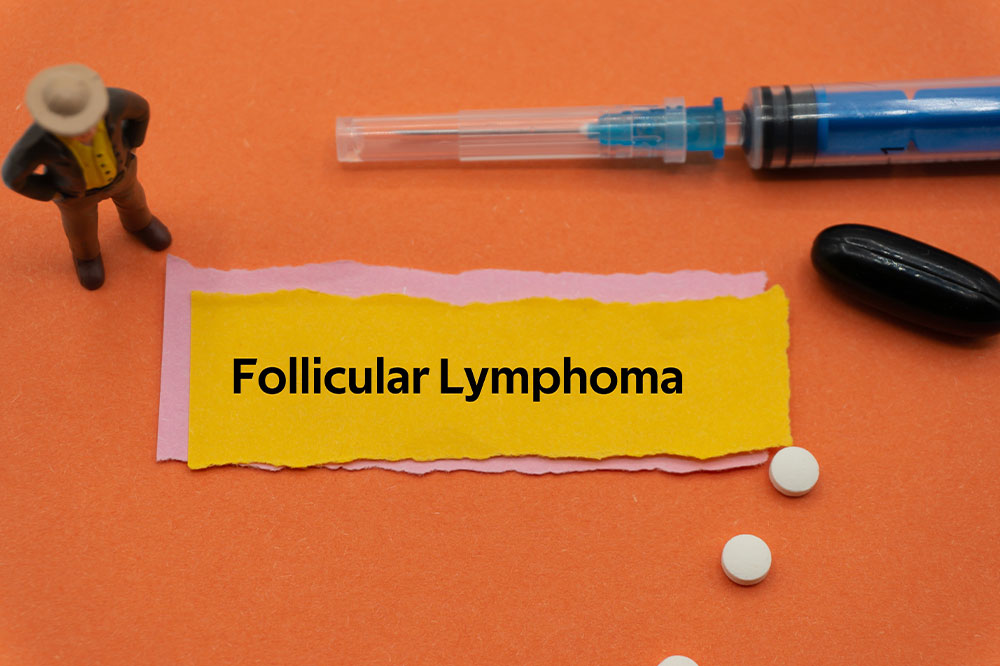
Follicular lymphoma – Causes, symptoms, diagnosis, and more
The lymphatic system consists of lymph vessels, glands, and lymph nodes. White blood cells in the lymphatic system are called lymphocytes and are further categorized as B and T lymphocytes. Follicular lymphoma develops mainly in the B-lymphocytes and is the most common subtype of Non-Hodgkin’s Lymphoma (NHL). Lymphoid tissues are found throughout the body; hence, follicular lymphoma can begin in any part of our body. It is a chronic disease without a cure yet.
Causes and risk factors of follicular lymphoma
Follicular lymphoma begins when the body starts producing abnormal B-lymphocytes in the lymph nodes or internal organs. Doctors have yet to identify a specific cause of the condition but have been able to associate many risk factors that can increase its occurrence. These factors include:
- Food
People who eat high amounts of meat and milk and include foods with a high concentration of nitrates are at a higher risk of developing follicular lymphoma. Studies indicate that a high intake of nitrate can increase the risk of follicular lymphoma by about 40%. - Exposure to chemicals
People exposed to chemicals like pesticides or solvents containing benzene are also at higher risk. People who work outdoors in the sun for long hours every day are also at risk of developing the disease later in life. - Existing health conditions
Those with a weakened or suppressed immune system or preexisting conditions like HIV or autoimmune diseases can develop follicular lymphoma.
Symptoms of follicular lymphoma
The most common symptoms of the condition include:
- Swelling in the lymph nodes
- Swelling in the lymph nodes in the neck, groin, or armpits is a common symptom of Follicular Lymphoma. If the swelling develops in deeper tissues, it can begin to put pressure on and compress the vital organs around the affected area. Some symptoms can be chronic cough, breathing problems, backaches, or pain in the abdomen.
- Unexplained fever and frequent infections
- Night sweats
- Sudden and quick reduction of body mass index
- Fatigue and exhaustion without any apparent cause
- Frequent bruising, bleeding in the gums and nose
- A sudden outbreak of red spots around ankles and shin areas.
Diagnosis of follicular lymphoma
Doctors use the following diagnostic tools to diagnose the condition:
- A thorough and detailed physical examination, particularly of the mouth and the skin.
- A complete blood count test to check abnormalities in white blood cells, red blood cells, and platelets
- Doctors perform a Lymph node biopsy if they detect abnormalities in the blood or physical examination. They remove a lymph node under anesthesia and test it under a microscope to look for lymphoma cells.
- Doctors advise patients to take imaging tests like a CT or PET scan to check for the exact location of cancer and to see its progression.
- Doctors may also perform a biopsy of bone marrow biopsy to check for cancerous lymphoma cells.
- If a person has severe headaches or problems with vision, they may have to do a spinal tap to check for lymphoma cells in the brain or spine. It may be followed by imaging tests to check the stage and spread of the cancer cells.
Stages of follicular lymphoma
Stage 1: The cancer is limited to one group of lymph nodes or one organ
Stage 2: In this stage, more than one group of lymph nodes or more than one organ is affected.
Stage 3: In this stage, cancer cells have spread to the organs close to the lymph nodes.
Stage 4: In this stage, cancer cells have affected the blood marrow or spread to distant organs.
Treatment of follicular lymphoma
A team of multi-disciplinary doctors design a treatment plan that considers a patient’s age, stage of cancer, current health condition, and any preexisting diseases. The common treatment for the disease include:
- Watchful waiting
Since follicular lymphoma is slow-growing cancer, doctors sometimes wait and watch for symptoms to change or develop before a patient needs treatment. The period of wait can range from three to 10 years. - Radiation therapy
Doctors use high-energy X-rays or other radiation therapies to kill the cancer-causing cells and prevent them from spreading and affecting other body organs. - Chemotherapy
Doctors use one or a combination of chemotherapy options and administer them orally and intravenously so that it reaches all areas of the body and destroys the cancer cells. If the cancer cells have aggressively multiplied and spread to the brain, doctors may administer the treatment into the cerebrospinal fluid. Doctors may use one or more chemotherapy treatments to increase the efficacy of the treatment. - Immunotherapy
Doctors administer these treatment options intravenously to boost people’s immune systems, killing cancer cells. - Bone marrow transplantation
Doctors may use bone marrow cells from a patient or donor to destroy the cancer cells and to produce healthy lymphoma cells.
Besides, doctors may also use a combination of radiation therapy, chemotherapy, immunotherapy, and bone marrow transplantation to ensure that the disease does not relapse in the near future.




